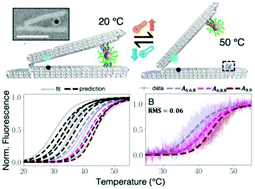A quantitative model for a nanoscale switch accurately predicts thermal actuation behavior†
Abstract
Manipulation of temperature can be used to actuate DNA origami nano-hinges containing gold nanoparticles. We develop a physical model of this system that uses partition function analysis of the interaction between the nano-hinge and nanoparticle to predict the probability that the nano-hinge is open at a given temperature. The model agrees well with experimental data and predicts experimental conditions that allow the actuation temperature of the nano-hinge to be tuned over a range of temperatures from 30 °C to 45 °C. Additionally, the model identifies microscopic interactions that are important to the macroscopic behavior of the system, revealing surprising features of the system. This combination of physical insight and predictive potential is likely to inform future designs that integrate nanoparticles into dynamic DNA origami structures or use strand binding interactions to control dynamic DNA origami behavior. Furthermore, our modeling approach could be expanded to consider the incorporation, stability, and actuation of other types of functional elements or actuation mechanisms integrated into nucleic acid devices.



 Please wait while we load your content...
Please wait while we load your content...